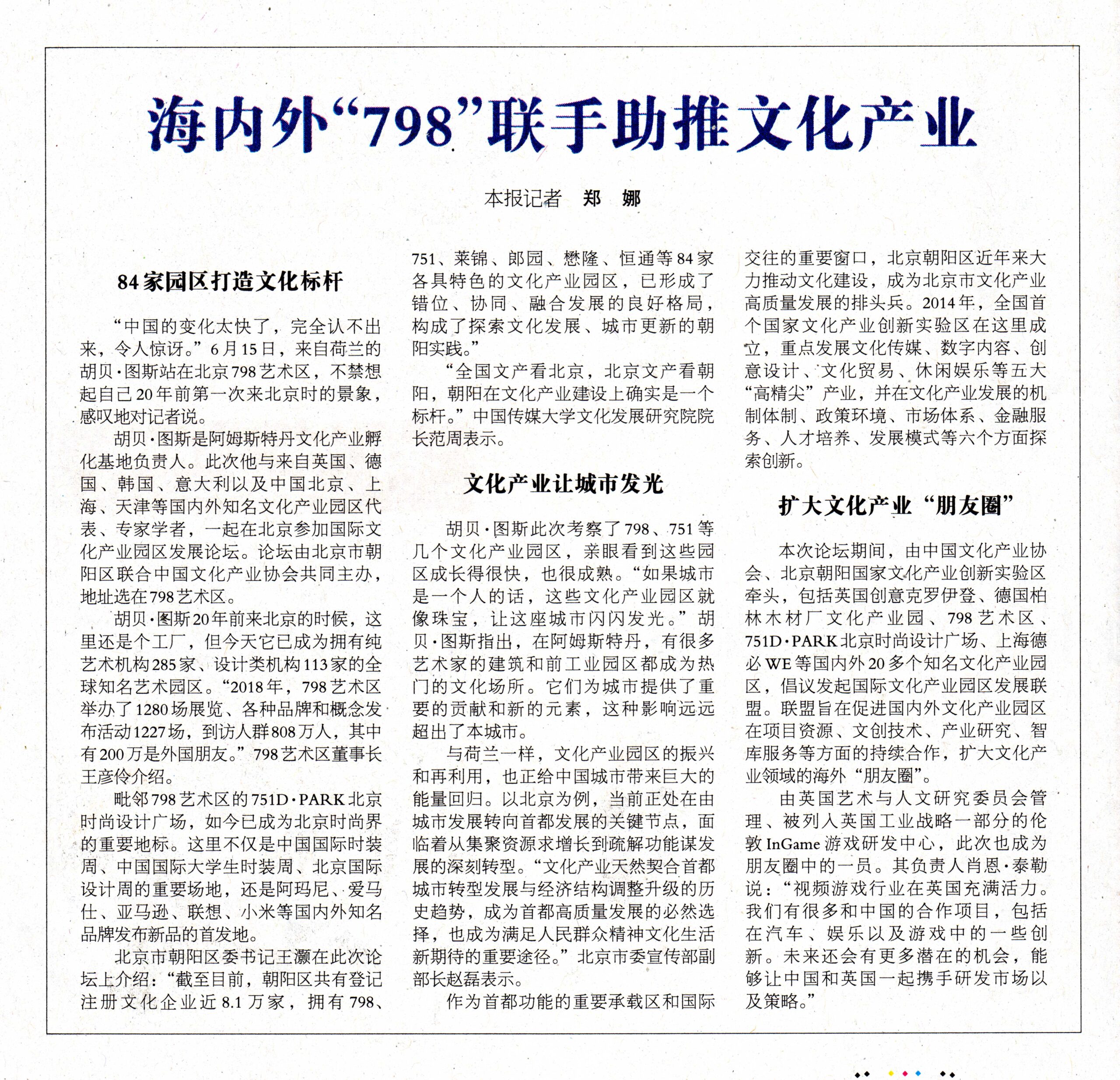At home and abroad “798 Art Zone” jointly give the cultural industry a boost!
84 Cultural Breeding Grounds create cultural benchmarks
“The changes in China are happening so fast that I can’t keep up with them, which is very amazing.” On June 15, 2019 Hubertus Bongers from the Netherlands stood in Beijing’s 798 Art Zone and couldn’t help to think of the time when he first came to Beijing 20 years ago: “This great economic expansion” and he sighed, the reporters saw.
Hubertus Bongers is founder of the Cultural Breeding Grounds in Amsterdam and the Netherlands. This time, he participated in the International Cultural Industry Park Development Forum in Beijing together with other experts, representatives and scholars from England, Germany, South Korea, Italy, Holland, Beijing, Shanghai, Tianjin and more well-known cultural industry parks at home and abroad. The forum is co-hosted by the Beijing Chaoyang District together with the China Cultural Industry Association and take place in the 798 Art Zone.
When Hubertus came to Beijing 20 years ago, 798 was still a factory, but today it has become a world-renowned art park with 285 fine art institutions and 113 design institutions. “In 2018, 798 Art Zone held 1,280 exhibitions and 1,227 various brand and concept release events, with over 8 million visitors, of which 2 million were foreign friends.” Wang Yanling, chairman of 798 Art Zone, declared.
Adjacent to the 798 Art Zone is the 751D·Park with the Beijing Fashion Design Plaza which has become an important landmark in Beijing’s fashion industry. This is not only an important venue for the China International Fashion Week, the Fashion Week College and the Beijing International Design Week, but also first place for the release of new products of well-known domestic and foreign brands such as Armani, Hermès, Amazon, Lenovo and Xiaomi.
Wang Hao, secretary of the Beijing Chaoyang District Party Committee, stated at the forum: “At this time, there are nearly 81,000 registered cultural enterprises in the Chaoyang District, with 84 cultural breeding grounds including 798 Art Zone, 751D·Park, Laijin, Langyuan, Maolong, and Hengtong. These unique breeding grounds and cultural industry parks have formed a healthy creative group pattern with excellent coordination and integration. They model a sunny practice in exploring cultural development and urban renewal.”
“The country’s cultural industry depends on Beijing and Beijing’s cultural industry depends on Chaoyang. Chaoyang is indeed a benchmark in the construction of cultural industries.” Said Fan Zhou, dean of the Cultural Development Research Institute from China’s Communication University.
The cultural industry makes the city shine!
Hubertus Bongers inspected several cultural industry parks such as 798 and 751 this time, and saw with his own eyes that these parks have grown and matured quickly. “If a city is like a person of character and these cultural industry parks and creative breeding grounds are its jewellery, together they make the city shine”. Hubertus pointed out that in Amsterdam, there are many former industrial areas and artists’ buildings with workshops, studios and shops for the creatives that have become very popular cultural places, especially for young people. They create new dynamic elements and make important urban contributions to the city, with an impact and power far beyond the city itself.
Like in the Netherlands, the reuse and revitalization into cultural industry parks is bringing huge energy back to Chinese cities. Taking Beijing as an example, it is currently at a critical juncture from urban development to capital development and is facing a profound transformation from agglomerating resources for growth to dispersing functions for development. “The cultural industry naturally fits the historical trend of the transformation and development of the capital city and the adjustment and upgrading of the economic structure. It has become an inevitable choice for the high-quality development of the capital and an important way to meet the new expectations of the people’s spiritual and cultural life.” Zhao Lei, deputy director of the Communication Department of the Beijing Municipal Party Committee, said.
As an important bearing area of the capital’s functions and an important window for international exchange, Beijing Chaoyang District has vigorously promoted new cultural constructions in recent years and has become the vanguard of the high-quality development of Beijing’s cultural industry. In 2014, the first experimental zone for innovation of the country’s national cultural industry was established here, focusing on the development of five “high-tech” industries such as cultural media, digital content, creative design, cultural economy and leisure & entertainment. Exploring and innovating in six aspects, including policy processes, market systems, financial services, development models and personnel trainings.
Expanding the “circle of friends” of the cultural industry!
During this forum, led by the China Cultural Industry Association and the Beijing Chaoyang National Cultural Industry Innovation Experimental Zone, including the British Creative Croydon, Holzmarkt Berlin Kulturindustriepark, Amsterdam Breeding Grounds, Beijing 798 Art District and 751D·PARK Fashion Design Plaza, Shanghai DoBe WE and more than 20 well-known cultural industrial parks at home and abroad proposed to launch the International Cultural Industrial Park Development Alliance. The alliance aims to promote the continuous cooperation of domestic and foreign cultural industry parks in project resources, cultural and creative technologies, industrial research, think tank services and to expand the overseas “friend circle” in the field of cultural industries.
The London InGame, Game R&D Center, managed by the British Arts and Humanities Research Council and the British Industrial Strategy, has also become a member of the circle of friends this time. Its director Sean Taylor said: “The video game industry is full of vitality in England. We have many cooperation projects with China, like innovations in automobiles, games and entertainment. There will be more potential opportunities in the future. Let China and England work together to develop markets and strategies.”
June 18, 2019 | Source: People’s Daily Overseas Edition
Our reporter Zheng Na |Editors in charge: Ma Lianghui (intern), Yang Mu.
